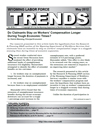
Long-Term Occupational Projections: 2011 to 2021
See related Tables and Figures
Wyoming is projected to add 40,874 jobs from 2011 to 2021, but the greatest opportunity for employment will be driven by the need to replace workers who leave the state's workforce over the next 10 years.
According to the latest projections from the Research & Planning section of the Wyoming Department of Workforce Services, Wyoming will need to fill 27,747 jobs during each of the next 10 years due to replacement need. These job openings are due to workers exiting Wyoming's labor force because of retirement, death, family obligations, or other reasons. By comparison, Wyoming is projected to add 4,087 new jobs annually during this period.
Several Wyoming industries are reliant upon workers ages 55 and older, specifically educational services (, health care & social assistance, and public administration (24.7%; Research & Planning, 2012). As more of these workers reach the traditional retirement age of 65 over the next 10 years, there will be a substantial need to fill positions as they are vacated. For example, the educational services industry is projected to add 811 new jobs annually, but will need to fill 2,556 openings annually due to replacement need.
Educational Requirements
Of the top 10 jobs with the highest number of annual openings, 6 require a high school education or less (see Table 1). These include jobs such as truck drivers, heavy and tractor trailer; bookkeeping, accounting, & auditing clerks; and nursing aides, orderlies, & attendants. Of these top 10 jobs, only registered nurses require an associate's degree, and only general & operations managers require a bachelor's degree. General & operations managers ($87,270) and registered nurses ($60,929) receive higher annual wages on average than any others in this top 10.
In general, jobs that require some form of postsecondary education are paid higher wages than those that require a high school education or less. The average annual wage for jobs requiring a high school education or less was $33,749, compared to $58,946 for jobs requiring a bachelor's degree (see Table 2). Of the top five occupations with the highest number of annual openings that required a high school education or less, two were paid average annual wages under $40,000. By comparison, of the top five occupations that required a bachelor's degree, all but one were paid more than $40,000 annually, on average.
Detailed short-term (2011-2013) and long-term (2011-2021) occupational projections by industry are available online at http://doe.state.wy.us/LMI/projections.htm.
Reference
Research & Planning, Wyoming Department of Workforce Services. (2012). Wyoming Wages by County, Industry, Age, & Gender, 1992-2011. Retrieved May 25, 2012, from http://doe.state.wy.us/LMI/earnings_tables/2012/index.htm


